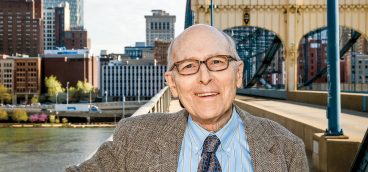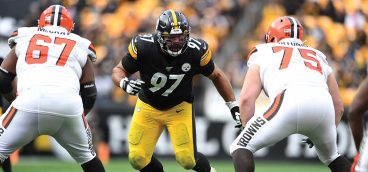Andy Masich: Pittsburgh Has a Story to Tell

My father was an engineer and my mother was a trained actress who went to school at Carnegie Tech, now Carnegie Mellon University. (Her first kissing scene was with Carl Betz, a Pittsburgher, who played the husband on “The Donna Reed Show.”) My parents met while doing community and summer-stock theatre. I have a wonderful photo of them on stage together.
I am one of four children, with an older brother and two younger sisters. My father died when I was just 8 years old of congestive heart failure, leaving my mom all on her own, with four kids. But when I was 16, she remarried. Our stepfather, a newly retired, disciplinarian school principal from Poughkeepsie, N.Y., had always dreamed of living in the American West. So, one summer, when he and my mom had been married for less than a year, they moved us all from Yonkers, N.Y., to Tucson, Ariz. Talk about culture shock. But, in retrospect, it was one of the best things that ever happened to me, even though I grumbled about it at the time.
When we arrived in Tucson—future historian that I was—the first question I asked was, “What happened here during the Civil War?” Nobody knew. There weren’t any books on the subject. So, after graduating from high school, I went on to get a B.A. and an M.A. in history at the University of Arizona in Tucson, and ended up writing the book I always wanted to read: “The Civil War in Arizona.” Before long, I went to work for a series of museums in Arizona and then in Colorado.
Andy Masich
- Senator John Heinz History Center, President and CEO (1998–present)
- Carnegie Mellon University, Ph.D., History (2014)
- Pennsylvania Historical and Museum Commission, Chairman and Commissioner (2011–present)
- Arizona Historical Society’s Central Arizona Division, Director (1985–1990)
- Rio Colorado Division, Director (1978–1985)
- University of Arizona, B.A., History and Anthropology (1977); M.A., History (1984)
As vice president at the Colorado Historical Society, I had 11 museums to mind, and my office was located in the main one, in Denver. One day, I got a call from a recruiter with the Korn Ferry organizational consulting group who said, “We think you should take a look at this history museum in Pittsburgh.” I wasn’t really interested in making a move at that time, but I liked the idea of Pittsburgh because I had family roots there going back five generations. All my grandparents, great-grandparents, and great-great-grandparents were buried in cemeteries in western Pennsylvania. I had been there as a boy for family reunions, but I never really got to know the city. So, I said, “Sure, I’ll take a look.”
Pittsburgh has more than its fair share of impressive history. It has a great story to tell and, at heart, I’m a storyteller who focuses on the human side of things. People are interested in people. And if you tell a good story about people in a way that engages your audience and provides a lesson, people will remember it, incorporate it into their lives and, hopefully, make good decisions in the present and plans for the future based on the wisdom of those who came before them. So, I went to visit Pittsburgh, fell in love with its people, even before I did the city, and accepted the job. The Senator John Heinz History Center was only half-built when I arrived and, while it had opened, it was not quite finished. But I was impressed with its board. They were determined to make the center work.
Back then, Pittsburgh had an identity crisis left over from the region’s post-industrial decline. I could see how badly the people needed a place that told their city’s story, something that would bolster civic pride. During my first month on the job, I reached out to historian and author David McCullough who was, in many ways, the inspiration for the History Center we have today. David believed that Pittsburgh deserved a major history institution but, at that point, all we had was a little place on Bigelow Boulevard in Oakland that was more a library and archive than a museum. It wasn’t big enough to handle large objects or exhibits. In time, David helped us to raise the money we needed to build a new museum, this one in the Strip District. He inspired us and gave us the confidence we needed to forge ahead. David is among the most important mentors in my life.
Given that my father died young, at age 40, it was my mother who raised me. Everything I am I owe to my mother, who was a strong woman. I don’t think she even had a driver’s license when my dad passed. She had to learn so many things quickly for us to have a chance. Eventually, she went back to school and became a public-school speech therapist while struggling mightily to keep us together. We were latch-key kids which, in some ways, was good. It taught us to be independent.
As a kid, every summer, my family would travel to Lake Chautauqua where my grandmother had a house and, for some reason, I often found myself in her attic. Nobody went up there but me. It was home to, among other things, a bunch of old steamer trunks and in one was a cigar box that contained marbles, pen knives, and what looked like a bullet of some sort. So, I grabbed that “bullet,” took it to my grandmother and asked, “What is this?” She said, “I don’t really know what it is or where it came from. It must have been your grandfather’s. Maybe it’s from Gettysburg.”
I was fascinated by that object and drew pictures of it in pencil. It is what’s called a cylindro-conoidal projectile—a pointed bullet with a hollow base. One day, I decided to write a letter to the Smithsonian Institution (on blue-lined, school notebook paper, no less) and enclosed with it one of the pictures I had drawn of my bullet. To their credit, one of the curators there wrote back and said, “What you have there, son, is a Minié ball”—a type of muzzle-loading, spin-stabilized bullet for rifled muskets named after its developer, Claude-Étienne Minié, inventor of the French Minié rifle. Minié balls came to prominence in the American Civil War, and revolutionized warfare. In fact, it’s the bullet that made the Civil War the deadliest war in American history.
So, obsessive as I am, I began collecting Minié balls. I wrote letters to people in the South and, sometimes, they’d just send them to me; some, I had to pay for. I wound up with the largest Civil War bullet collection in Yonkers. I then turned my boyhood bedroom into a museum. I made hats out of paper mâché and swords out of wood. The Civil War-era “Monitor” and “Merrimack” ships were made from popsicle sticks. I put labels on everything. And to enter my “museum,” you had to take a brochure of my own creation from a rack on my door. I got increasingly interested in the Civil War, so much so that I even collected Civil War Centennial trading cards.
Years later, when I was working at the Colorado Historical Society, I heard that Michael Shaara’s Pulitzer Prize-winning novel, “The Killer Angels,” about the Battle of Gettysburg, was going to be made into a movie. It was my favorite book about the war (and was also a favorite of Ken Burns, who was inspired by it to create his famous Civil War series for PBS). I had heard that Robert Redford bought the rights, so I called him and, of course, got his housekeeper. I told her, “I have to be in this movie.” She transferred me to Redford’s office manager who said, “Mr. Redford no longer owns the rights to that book. He sold them to Kevin Costner.” So, I called Costner and didn’t get him, either. I got his assistant, and she said, “Mr. Costner no longer owns the rights to that book. He sold them to Ted Turner.” So, naturally, I called Ted Turner’s office and convinced his people that I simply had to be in any movie that was made based on Michael Shaara’s book. Incredibly, they hired me as a “background artist,” which is one step above an “extra.” But unlike an extra, a background artist could have a speaking part and appear close-up in the background of a movie scene. For 12 days, I took part in the filming at Gettysburg. I’m in the movie for 47 seconds. I even had a line but, sadly, it got cut. When it was made, the film was to be called “The Killer Angels,” for obvious reasons. But about six weeks before its release, the film company’s marketing department asked, “So, what’s this movie about? ‘The Killer Angels’ sounds like a ‘biker flick.’” They were told, “It’s about the Civil War battle of Gettysburg,” to which they replied, “Then why don’t you just call the movie ‘Gettysburg?’” And they did.
Back at the History Center, it was evident to me that, while we now had a large building, there wasn’t space enough to mount changing exhibits. We only had little nooks and crannies for long-term, permanent ones. We couldn’t bring in a 5,000- or 10,000-square-foot temporary show, something with critical mass, to draw a bigger audience. So, we were determined to build a changing exhibit gallery that would allow us to take on big projects.
In 1999, a year after I arrived at the center, I approached the Smithsonian Institution and said, “You have 144 million objects and specimens in your collection. I’d like to exhibit some of them in Pittsburgh.” They had tons of World War II material and many patent models of things that had been invented here. They agreed to work with us, and we completed the affiliation in 2000. Becoming a Smithsonian affiliate meant that we had a contract with the world’s largest museum that requires us to have Smithsonian objects on exhibit at all times. Today, on our first floor, we have the world’s first Jeep, which was made in Butler, Pa., in 1940, and given to the Smithsonian by the U.S. War Department before the D-Day Invasion. They knew it was an important object, one that had replaced the horse and really changed things on the battlefield. Think about it now in terms of public acceptance. Every SUV owes its heritage to that little car.
In 2004, we finally built an addition to the History Center. We expanded the space to include the McGuinn Gallery (named after the former head of Mellon Bank, Marty McGuinn, who was and still is a strong supporter of ours) and the “Western Pennsylvania Sports Museum.” Can you imagine the “City of Champions” without a sports museum? Odd, too, was the fact that there were no firearms in our collection at all, and no exhibits that dealt with war. It’s OK to tell the story of a kinder, gentler Pittsburgh. But what of the “Arsenal of Democracy”? So, we wrote a strategic plan and put together a committee of around 100 Pittsburghers to talk about what they would like to see in their museum. We conducted interviews and focus groups, and did surveys asking, “What stories are important to you?” and came up with a new interpretive plan for the Heinz History Center.
When we were planning the expansion, I made sure that the architects knew that the floor of the gallery had to be strong enough to support a Sherman tank. After all, strength is part of our DNA. During World War II, Pittsburgh made more steel than all the Axis Powers put together, which gave us strength, toughness and resilience; that “can do” spirit. Today, we’re “eds, meds and robotics.” That’s the future of Pittsburgh, for sure. But there’s no reason for us to deny what made us who we are. And when we created our exhibit called “We Can Do It: World War II,” we really did exhibit a Sherman tank in the gallery.
In retrospect, it was a good thing that we built a 10,000-square-foot, changing exhibit gallery on our first floor because, when it came time for the Smithsonian to re-do its Air and Space Museum in Washington, they had to move the original Apollo 11 capsule, and we were one of only four museums in America that were given the honor of exhibiting it. It weighed 17,000 pounds, and we had to demonstrate that our gallery floor could handle it. We knew it could handle a Sherman tank, so the space capsule presented no problem. We also had a 20-foot door that the capsule could easily roll through.
In normal times, 350,000 people a year visit the Heinz History Center. Many people, I’m sure, do not know that we also operate the Fort Pitt Museum and the Meadowcroft Rockshelter and Historic Village in Avella, Pa., the oldest site of human habitation in North America. So, we have tried many new things during my time here, and have helped to develop a collaborative museum system throughout Pittsburgh and the surrounding region.
In a way, the COVID-19 pandemic has propelled our strategic plan forward even faster than we anticipated. Into the future, we believe that we must deliver our message in broad strokes, through radio and television, and by way of the internet via podcasts, webinars and video presentations. I’m also continuing to communicate our message on national television through the History Channel. I believe that the future is not only about people coming to the History Center in person; it’s about the History Center being welcomed into people’s homes by way of new technology and new communication tools.
Some of my colleagues in the history world worry about the risk of giving away the store. “Who will come to our museums if we give it all away virtually?” I don’t subscribe to that theory. I believe that there will always be a demand for the genuine article. When I was in Arizona, I did a weekly television show so, when I came here, I teamed up with KDKA-TV to do a show called “Pittsburgh’s Hidden Treasures,” which was kind of like “Antiques Roadshow.” We did 11 seasons of that, and it was a terrific way to connect with the people of Pittsburgh through their own collections, objects and histories. I still do “Pittsburgh Time Capsules” on KDKA-AM, which are short subjects—one-to-two-minute histories. And I’m a regular on TV’s “Pittsburgh Today Live,” and on KDKA radio’s morning show. I believe that having good relations with the media, locally and nationally, is very important. And I’m sure that people will still want to come together for in-person social experiences at the History Center itself.
When I first arrived at the Heinz History Center, we were having financial problems, and people wondered, “Could this museum really survive?” We had no endowment. People have the misimpression that, since we carry the “Heinz” name, we are supported financially by The Heinz Endowments and/or the H.J. Heinz Company. The truth is, we apply for grants, just as other institutions do, and occasionally, we get them. But that accounts for only about 2 percent of our budget. We’re essentially a pull-yourself-up-by-your-bootstraps organization. Government support accounts for about 7 to 8 percent. And more than 30 percent of our budget comes from earned income. We have about 6,000 dues-paying members. Every year, we host many rights-of-passage events: weddings, bar mitzvahs, memorial services, retirement parties and corporate retreats. People have come to see the History Center as a great place to hold catered events, which is now a million-dollar business for us. And let’s not forget donations from the public. Since I’ve been here, we’ve increased our endowment from about $2 million to $30 million, which helps us to defray many of our operating expenses. But we still have to work very hard every year to make ends meet.
To me, we’re doing exciting things at the Heinz History Center, but our work is not finished, even though we’ve got one of the largest and most admired history centers in America today. People come from all over the country to see how we did it. Representatives of other cities come and ask, “How did you transition from your industrial base?” and “How did your ‘renaissance’ work?”
My roots in Pittsburgh are deep. Even though I didn’t grow up here, I’ve been at the History Center for 22 years now and feel like a true Pittsburgher. I sometimes tease people that homing devices are implanted in Pittsburghers when they’re born. My wife, Debbie, is a critical care nurse at Shadyside Hospital. We have raised three kids who have flown the coop and moved out West. But when people ask them where they’re from, they all say “Pittsburgh,” proudly. And, I think that if the right opportunities opened up for them here, they’d all come home.






